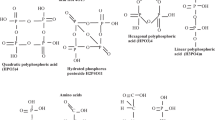Summary
The incorporation of 32P i into the nucleic acids of green and bleached cells of Euglena gracilis was investigated. Optimum short-time labelling could be achieved by subjecting the cells to phosphate starvation for 4 h followed by an incubation with 32P i for 2 h. In bleached cells the amount of 32P incorporated was about 5.5 times higher than that in autotrophic cells. The role of phosphate in the nucleic acid metabolism of autotrophic cells was demonstrated by the results of starvation experiments. Under this condition the various nucleic acid components were degraded in the following order: soluble RNA, ribosomal RNA, DNA. However, even after 144 h of phosphate starvation the autotrophic cells were found to recover rather rapidly when transferred to normal growth conditions. 45 h after the transfer the nucleic acids were again present in the normal pattern. Nucleic acid preparations from phosphate starved cells contained various types of condensed inorganic phosphates. According to the length of the starvation time their amounts and compositions differed as indicated by the chromatographic behavior.
Zusammenfassung
Der Einbau von 32P-Orthophosphat in die Nucleinsäuren grüner und gebleichter Zellen von Euglena gracilis wurde untersucht. Optimale 32P-Kurzzeit-Markierung konnte nach 4 Std Kultur der Zellen in phosphatfreiem Medium, gefolgt von einer Inkubation mit 32P-Orthophosphat für 2 Std, erreicht werden. Die heterotrophen Zellen zeigten dabei einen etwa 5,5fach höheren Einbau als die autotrophen. Die Bedeutung von Phosphat für den Nucleinsäure-Stoffwechsel autotroph kultivierter Zellen wird anhand von Verarmungsversuchen aufgezeigt. Zunehmende Phosphatverarmung führte zunächst zum Abbau der niedermolekularen RNS, später zur Reduzierung der hochmolekularen ribosomalen RNS; die DNS wird hingegen erst relativ spät von der Verarmung betroffen. Nach 144 Std im phosphatfreien Medium erholten sich die Zellen relativ schnell, wenn sie in komplettes Nährmedium überführt wurden: nach 45 Std Erholungszeit war die Garnitur ihrer Nucleinsäuren wieder komplett. Die extrahierten Gesamtnucleinsäuren phosphatverarmter Zellen enthielten kondensierte anorganische Phosphate. Ihre Menge und Zusammensetzung änderte sich in Abhängigkeit von der Dauer der Verarmung.
Similar content being viewed by others
Literatur
Beiderbeck, R.: Zur Frage DNA-assoziierter RNA in Zellen der Grünalge Chlorella. Dissertation, Universität Tübingen 1968.
Brawerman, G., Hufnagel, D., Chargaff, E.: On the nucleic acids of green and colorless Euglena gracilis. Isolation and composition of DNA and transfer RNA. Biochim. biophys. Acta (Amst.) 61, 340–345 (1962).
Buetow, D. E., Schuit, K. E.: Phosphorus and growth of Euglena gracilis. J. Protozool. 15, 770–773 (1968).
Epstein, H. T., Allaway, E.: Properties of selectively starved Euglena gracilis. Biochim. biophys. Acta (Amst.) 142, 181–194 (1967).
Kempner, E. S., Miller, J. H.: The molecular biology of Euglena gracilis. I. Growth conditions and cellular composition II. Utilization of labelled carbon, sulfur and phosphorus. Biochim. biophys. Acta (Amst.) 104, 11–24 (1965).
Niemeyer, R., Richter, G.: Schnellmarkierte Polyphosphate und Metaphosphate bei der Blaualge Anacystis nidulans. Arch. Mikrobiol. 69, 54–59 (1969).
Richter, G.: Pulse-labelling of nucleic acids and polyphosphates in normal and nucleate cells of Acetabularia. Nature (Lond.) 212, 1363 (1966).
Smillie, J. A., Krotkov, G.: Phosphorus containing compounds in Euglena gracilis grown under different conditions. Arch. Biochem. 89, 83–90 (1960).
Spiess, E., Richter, G.: Die Nucleinsäuren grüner und gebleichter Zellen von Euglena gracilis. Arch. Mikrobiol. 53, 195–207 (1966).
——: Isolierung und Charakterisierung schnell markierter RNS von Euglena gracilis mit Hilfe analytischer und präparativer Elektrophorese in Polyacrylamid-Gelen. Arch. Mikrobiol. 75, 37–58 (1970).
Author information
Authors and Affiliations
Rights and permissions
About this article
Cite this article
Spiess, E., Richter, G. 32P-Markierung der Nucleinsäuren und Bedeutung des Phosphats für den Nucleinsäure-Stoffwechsel bei Euglena gracilis . Archiv. Mikrobiol. 78, 118–127 (1971). https://doi.org/10.1007/BF00424868
Received:
Issue Date:
DOI: https://doi.org/10.1007/BF00424868



